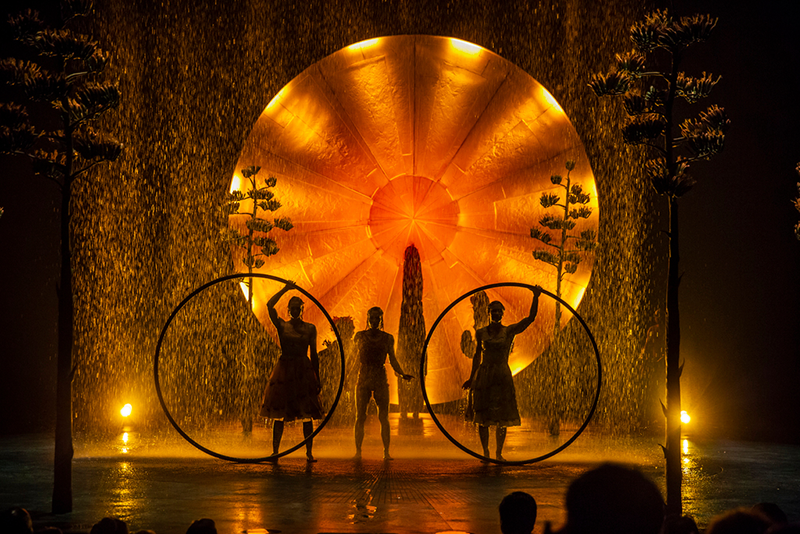
Each Cirque Du Soleil spectacle has its own special themes, and for one of their most recent touring shows, Luzia, those include air, water, and the flora and fauna of Mexico. The art and culture from south of the border is beautifully displayed in this production full of colorful lighting, costumes, and set design, dynamic puppetry, live musicians, and dazzling acrobatics. A strong aspect of Luzia is water, which is used for key moments. There is the rain curtain that showers water down on acrobats using ropes and hoops and also produces striking images, as well as a pool of water at the center of the interior turntable. The pool is inspired by cenotes, which are natural sinkholes found in Mexico created after a cave ceiling collapse.

There are two turntables on the Luzia stage that are frequently used. The outer diameter of the main turntable is 40 feet, the inner reaches 34 feet, and the diameter of the pool is 10 feet. The pool in the center actually fills with water during an elegant sequence involving a shirtless man flying in, out, and around the pool on a sturdy strap while also interacting with a jaguar puppeteer. Vines hang down around him from the grid above. Naturally, a drainage system is important here.
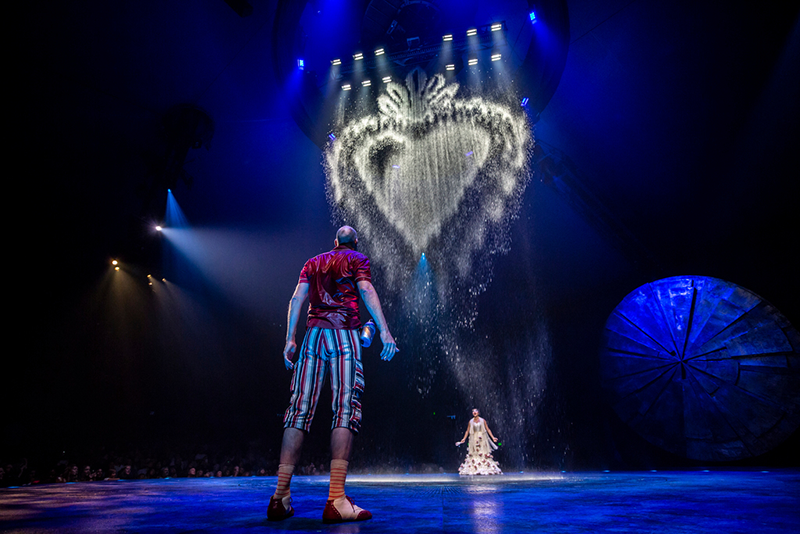
Behind-the-Scenes Plumbing
“We don’t actually drain it out,” clarifies the show’s technical director, Mitchell Hunt, who is in his third year working for Cirque. “One of the things with Cirque is being socially responsible and environmentally responsible, so we recycle as much of the water as we possibly can. What you wouldn’t have seen as an audience member is that we actually have a full-sized semitrailer water treatment plant placed behind the big top. That trailer has water storage, water filtration, chlorination and UV systems, and a heating system as well as the pumps and the mechanisms that are there to run the whole system, which is fully automated and regulated.”
The Luzia crew does not tour with water. They drain it at the end of each individual run. When they come to a new city, the initial fill is about 10,000 liters (2,642 gallons). They use a computer that senses and analyzes the fresh water to determine its level of alkalization and the level of micro particles.
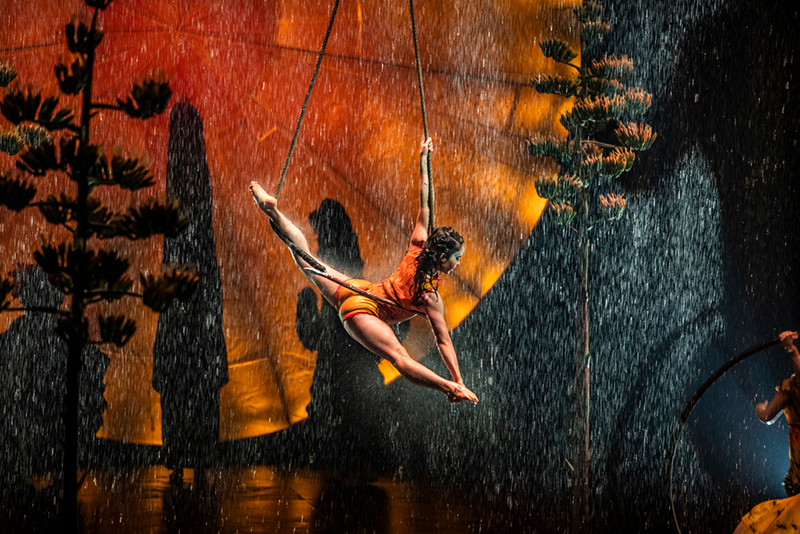
“It give us a level of the health of the water, or the cleanliness of the water,” explains Hunt. “At that point, the computer will start to make decisions about what we need to do to get the water de-ionized to make it electrically safer. We actually take salt and conductive materials out of the water, and then we’ll boost it to a level that’s acceptable for atomization, so that if the particles are breathed in by our audience, there’s no contamination potential. The computers are all always tracking the health and conductivity of the water. From that point, we circulate it constantly. On a daily basis, it’s going through a micro filtration and ultraviolet filtration system. It circulates the 10,000 liters about six times per hour.”
The stage itself is perforated. There are holes in the surface of the stage, and underneath the turntable cart “are a stainless steel structure and pan that funnel the water back into the pool in the center of the stage,” says Hunt. “That’s the way we capture the rain and put it back into the system. Then the pool is constantly circulating from the center stage out to the truck and back in, and that’s for filtration, cleanliness, and heating.”
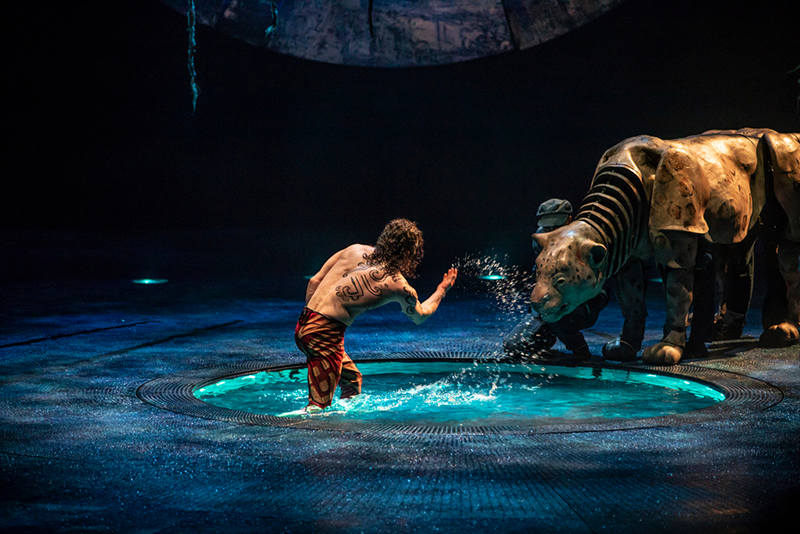
The Pool and Rain Curtain Systems
There are two circulation loops for the show. One loop runs from the filtration system to the pool, the other from the filtration system to the rain curtain. They run a loop up to the rain curtain to keep warm water circulating. They do not want the performers to be waiting for warm water as if they were in a shower at home. “We actually circulate hot water up to the rain curtain permanently,” says Hunt, “so that any time we turn the curtain on to rain on stage, that water is instantly warm and the artists don’t ever get a chilled shock, which obviously can be a safety concern for their muscles.”
Hunt estimates that there are 300 feet of 3”-4” circulation pipes being used on the show, with approximately “60 to 80 feet for the pool to go back and forth for circulation. Call that 140 feet of hose, and then you’ve got a 40 foot rise to the cupola.” The electrical grid is 40 feet above the stage, and the rain curtain is 30 feet long. “You’re looking at something in the order of about a 12-foot rigging grid that hangs above the rain curtain,” adds Hunt.
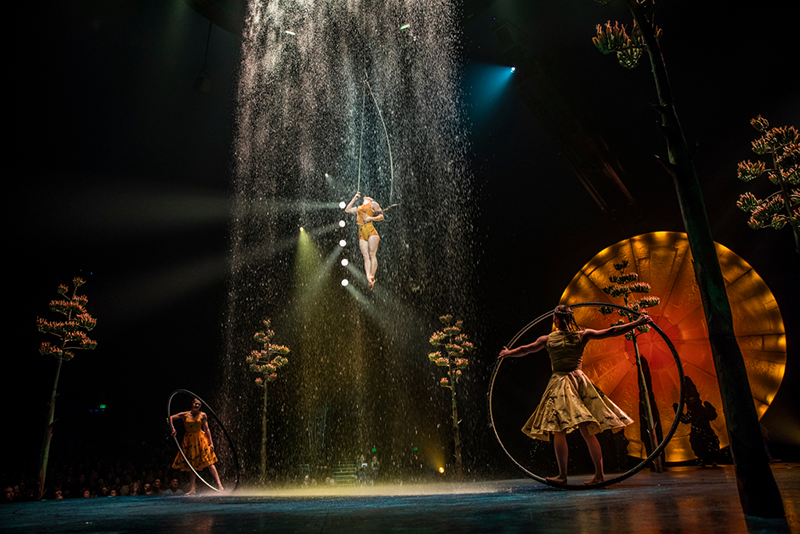
The grid is bolted to the cupola, which is essentially the structure of the tent. “When you see the tent from the outside, the cupola is the big, sausage shaped structure at the top that generally has Cirque Du Soleil written on it,” says Hunt. In the grid, the riggers have the winch, control system, and communications system. “We can have four riggers or artists up there at the same time. That’s the top grid.”
Below that sits the rain curtain, which they can track on and off stage as needed. “When it comes into position onstage, there is what we call the donut,” says Hunt. “The donut is rigged with the winch line around the rain curtain so that the line doesn’t foul or catch on the rain curtain. Then, below the track, is another mechanism which is the rain curtain rotate access itself, and that’s what they call the slip ring. The ring has inner and outer contact points, and it can rotate infinitely whilst maintaining communication and electrical contact. The slip ring is actually the most crucial part of that system, because it allows the rain curtain to move without losing electrical connection. There’s a similar device that goes to the center of that, which is a slip ring for water. The water hose connects into the center of that, and then the rain curtain can move and rotate without twisting the hoses. In other words, the rain curtain can actually rotate infinitely. We don’t ever have to return to zero. It doesn’t ever have to be unwound.”
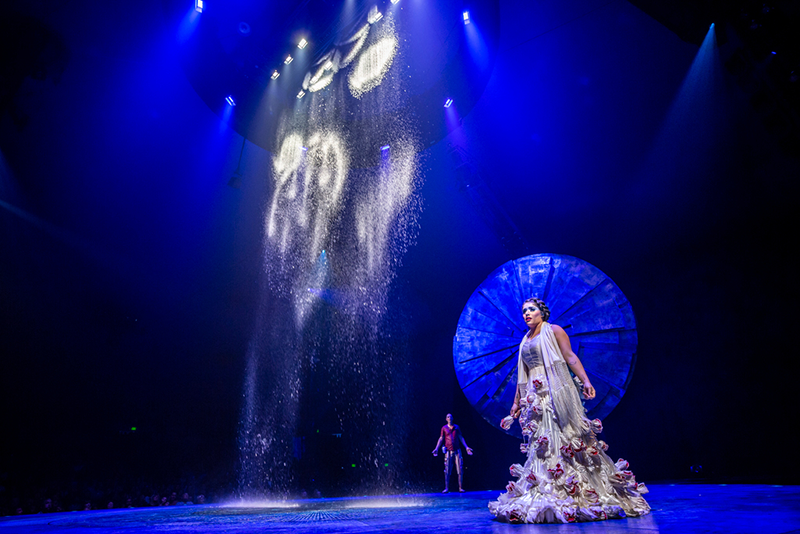
Lighting the Rain
It turns out that part of the lighting grid is actually on the rain track itself. The production has “a very complex grounding structure,” says Hunt. “That’s also why we de-ionize the water. Everybody thinks the water is conductive, but it actually isn’t. Water is only conductive if it contains minerals that are conductive. We actually take those minerals out of the water so it is effectively neutral. It decreases the electric shock factor quite a lot. But it doesn’t decrease the fact that equipment doesn’t like being wet.”
At one point in the show, the rain curtain produces some wonderful images such as hearts (through the water) falling to the stage. When asked about that design aspect, Hunt makes a comparison to the way that old-fashioned dot matrix printers would create images through using more or less dots on each line to create space.
“It’s effectively that, in a much more complex way,” elaborates Hunt. “There are 174 electromagnetic valves that operate under vacuum. When electricity is applied to them, those valves open or close depending on the polarity. There are nine water tanks, three per section. Those water tanks fill when they get the command from the computer, and then those electromagnetic valves below them open and close. They’re dropping a portion of water, and that creates the dots. As each valve open and closes, it creates one pixel worth of water, and they can open and close 20 times a second. So the speed at which they open and close, and the combinations or the patterns of which they are opening and closing, create the image below.”
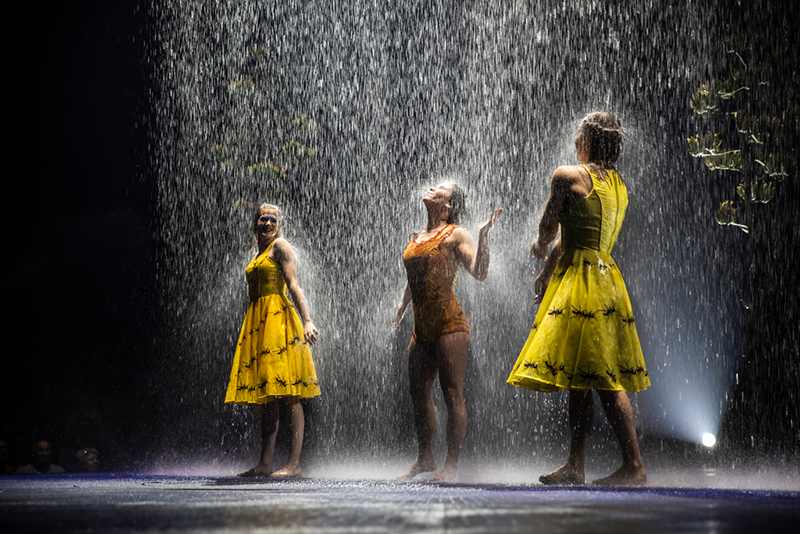
The rain curtain is controlled by the lighting desk via a DMX512 control, which is talking to a computer and telling it what images trigger at what speed. The Luzia crew does not have a separate control surface for the rain curtain. It is controlled through the grandMA used for the lighting system.
“The main moment is in the final piece of the first act,” says Hunt. “The stage and the curtain rotate at the same pace so that the entire audience gets to experience the imagery in the curtain, not just the people directly in front of it. The other thing with the water curtain is that is an important key feature for lighting because when rain curtains are not lit well, they cannot really communicate as desired and look a bit flat. There are a lot of angles of lighting and conceptual things that have to be considered in that as well. It’s not so much about fixture, it’s more that more about angles and color choices and just being sensitive to that.”

Hunt praises the “amazing team of technicians” on Luzia who work day and night to keep everything running. He says they have to be process orientated and systems orientated to make sure they are planning ahead.
“We’ve got 13 axes of automation, so there are a lot of automated parts,” says Hunt. “I think the thing that’s beautiful about Luzia is that you never watch the show thinking it’s a show about technology. It really is a show where the technology is there to support the artistic outcomes, to support the acrobats in their art and what they do, but it never takes over from that. I think that’s an important balance for shows in the future, to keep in mind that there’s something sacred about live performance, and we should be enhancing that, not detracting from it.”


